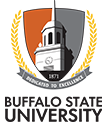
Indigenous Initiatives Caucus at Buffalo State
The Legacy Committee was first established as an ad hoc committee with support from the Civic and Community Engagement Office. It was created as a direct result of conversations that were generated from the Campus Compact webinar “Decolonizing Approaches to Inclusive Discussions and Trainings: Lessons from Indigenous Perspective” which was held on November 14, 2019.
Founding members of the committee included Tonya Ackley (Civic and Community Engagement Office), Patricia Jones (Senior Academic Advisor), and Lisa Marie Anselmi (Anthropology). The Legacy Committee pulled together on-campus initiatives aimed at making Buffalo State a welcoming environment for Indigenous Students.
This included initiatives through the Native American SUNY: Western Consortium (NASWC) and when it is re-recognized, the efforts of the Native American Student Organization (NASO).
The Legacy Committee has now evolved into the Indigenous Initiatives Caucus. Current members include Tristan Salter (Continuing Professional Studies/MECHS), Patricia Jones (Senior Academic Advisor), Lisa Marie Anselmi (Anthropology), Ashley Maracle (The Counseling Center), Julie Setele (Butler Library), Gabriela diSpirito (Equity and Diversity), and Elizabeth Hartz (Health, Nutrition, and Dietetics).
Land acknowledgments are formal statements that introduce, recognize, and offer respect to Indigenous Peoples as traditional stewards of the land on which the institution stands and the enduring relationship between that land and Indigenous Peoples. They are widely used in Canada (and have been for 15-20 years or so) and are increasingly being adopted by institutions here in the United States including national and regional higher education conferences like ACPA and WNY Advising Conference.
A sample Land Acknowledgement for Buffalo State, which was approved by the university's Equity and Diversity Council:
"Buffalo State University would like to start by acknowledging that the campus is situated within the traditional territory of the Haudenosaunee Confederacy, including the Seneca, Tuscarora, Cayuga, Onondaga, Oneida, and Mohawk nations, and of their Indigenous relations and neighbors, the Erie and the Wenro. We hope to demonstrate respect for the treaties that were made on these territories and we pledge to work toward partnership with a spirit of collaboration with our current Indigenous neighbors, the Seneca and Tuscarora.”

